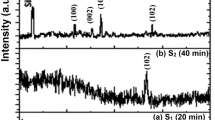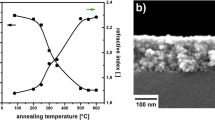Abstract
TiO2 and Nb-doped TiO2 films were prepared by sol–gel processing, their microstructure was adjusted by varying the number of subsequent coating-firing cycles that resulted in final total film thickness of ~100 nm. When only few subsequent coatings are stacked (large single layer thickness) granular polycrystalline microstructures are observed. Doping with Nb reduces the crystallite size compared to the respective pure anatase films. When the single layer thickness is reduced, the film growth is successively dominated by the nucleation of subsequent films on the underlying crystalline material resulting in a columnar dense film structure. The multilayer architecture of such films can be demonstrated by defocus TEM imaging even if crystalline columns exceed single film boundaries. Results indicate that Nb is homogeneously incorporated into the anatase lattice by substitution of Ti, nevertheless the electric conductivity after H2 post annealing is significantly lower than reported for analogous films prepared by magneton sputtering or pulsed laser deposition.








Similar content being viewed by others
References
Brinker C, Scherer G (1990) Sol–gel science—the physics and chemistry of sol–gel processing. Academic Press, Boston
Schottner G (2001) Chem Mater 13:3422
Mackenzie J (2003) J Sol–Gel Sci Technol 26:23
Bockmeyer M, Löbmann P (2006) Chem Mater 18:4478
Reaney I, Taylor D, Brooks K (1998) J Sol–Gel Sci Technol 13:813
Risse G, Schlobach B, Haessler W, Stephan D, Fahr T, Fischer F (1999) J Eur Ceram Soc 19:125
Wang S, Qiu L, Wang L, Du P, Chen S, Han Z (2005) Supercond Sci Technol 18:1271
Kozuka H, Takenaka S, Tokita H, Hirano T, Higashi Y, Hamatani T (2003) J Sol–Gel Sci Technol 26:681
Bockmeyer M, Löbmann P (2007) Thin Solid Films 515:5212
Schuler T, Aegerter M (1999) Thin Solid Films 351:125
Schuler T, Krajewski T, Grobelsek I, Aergerter M (2004) J Sol–Gel Sci Techno 31:235
Schuler T, Krajewski T, Grobelsek I, Aergerter M (2006) Thin Solid Films 502:67
Bockmeyer M, Herbig B, Löbmann P (2009) Thin Solid Films 517:1596
Beaurain A, Luxembourg D, Dufour C, Koncar V, Capoen B, Bouazaoui M (2008) Thin Solid Films 516:4102
Lin K, Tsai P (2007) Thin Solid Films 515:8601
Szyszka B (2001) Vakuum Forsch Prax 1:38
Minami T (2005) Semicond Sci Technol 20:S35
Schmidt-Mende L, MacManus-Driscoll J (2007) MaterialsToday 10(5):40
Puetz M, Aegerter M (2008) Thin Solid Films 516:4495
Prodi-Schwab A, Luethge T, Jahn R, Herbig B, Loebmann P (2008) J Sol–Gel Sci Technol 47:68
Furubayashi Y, Hitosugi T, Yamamoto Y, Hirose Y, Kinoda G, Inaba K, Shimada T, Hasegawa T (2006) Thin Solid Films 496:157
Hitosugi T, Ueda A, Furubayashi Y, Hirose Y, Konuma S, Shimada T, Hasegawa T (2007) Jpn J Appl Phys 46(3):L86
Yamada N, Hitosugi T, Hoang N, Furubayashi Y, Hirose Y, Shimada T, Hasegawa T (2007) Jpn J Appl Phys 46(8A):5275
Sato Y, Akizuki H, Kamiyama T, Shigesato Y (2008) Thin Solid Films 516:5758
Löbmann P (2005) J Sol–Gel Sci Technol 33:275
Diaz-Parralejo A, Caruso R, Ortiz A, Guiberteau F (2004) Thin Solid Films 458:92
Zhang Y, Reller A (2002) Mater Sci Eng C 19:323
Acknowledgments
This work has been funded within the framework METCO of the Fraunhofer-Gesellschaft. The authors gratefully acknowledge Annett Halbhuber’s careful and accurate dedication to the preparation of multiple coatings.
Author information
Authors and Affiliations
Corresponding author
Rights and permissions
About this article
Cite this article
Wang, C., Meinhardt, J. & Löbmann, P. Growth mechanism of Nb-doped TiO2 sol–gel multilayer films characterized by SEM and focus/defocus TEM. J Sol-Gel Sci Technol 53, 148–153 (2010). https://doi.org/10.1007/s10971-009-2070-7
Received:
Accepted:
Published:
Issue Date:
DOI: https://doi.org/10.1007/s10971-009-2070-7




